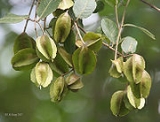
Terminalia arjuna
Overview
Terminalia (plant)
Terminalia is a genus of large trees of the flowering plant family Combretaceae, comprising around 100 species distributed in tropical regions of the world. This genus gets it name from Latin terminus, referring to the fact that the leaves appear at the very tips of the shoots.Trees of this genus...
.
The Arjuna is about 20-25 metres tall; usually has a buttressed trunk, and forms a wide canopy at the crown, from which branches drop downwards. It has oblong, conical leaves which are green on the top and brown below; smooth, grey bark; it has pale yellow flowers which appear between March and June; its glabrous, 2.5 to 5 cm fibrous woody fruit, divided into five wings, appears between September and November.
The Arjuna is usually found growing on river banks or near dry river beds in West Bengal
West Bengal
West Bengal is a state in the eastern region of India and is the nation's fourth-most populous. It is also the seventh-most populous sub-national entity in the world, with over 91 million inhabitants. A major agricultural producer, West Bengal is the sixth-largest contributor to India's GDP...
and south and central India
India
India , officially the Republic of India , is a country in South Asia. It is the seventh-largest country by geographical area, the second-most populous country with over 1.2 billion people, and the most populous democracy in the world...
.
The Arjuna is one of the species whose leaves are fed on by the Antheraea paphia moth which produces the tassar silk (Tussah), a wild silk
Wild silk
Wild silks have been known and used in many countries from early times, although the scale of production is far smaller than that from cultivated silkworms.-Background:...
of commercial importance.
In studies in mice, its leaves have been shown to have analgesic and anti-inflammatory properties.
The Arjuna was introduced into Ayurveda as a treatment for heart disease by Vagbhata (c.

